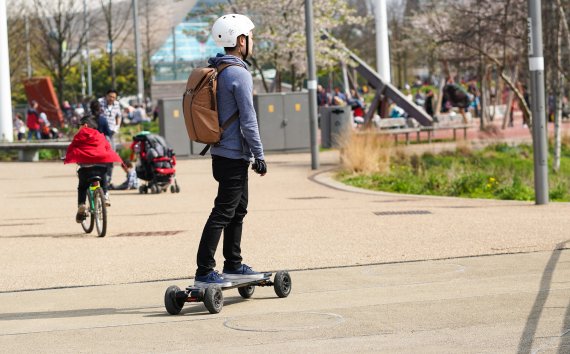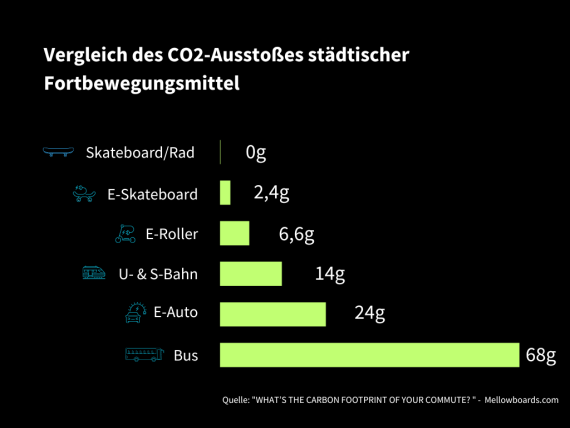
The transportation challenges of metropolitan areas are well known: Lack of space, noise and air pollution. The solutions are also clear: electromobility, bike paths, mass transit. In addition, micromobility is needed for the short distances that make up the majority of urban movements.
When we think of means of transportation in urban areas, bicycles, cargo bikes or e-scooters usually come to mind. But one familiar vehicle is increasingly coming to the attention of environmentally conscious commuters: the skateboard. Skateboards are compact, require no parking space, have virtually a zero-emissions footprint, and allow for a little skater feeling before and after the office job. Thus, they are predestined to be the poster boy of micromobility. But are they really sustainable?
- Skate Green: The future of environmentally conscious boards
- Size vs. functionality: evolution of skateboard design
- Electrification: e-skateboards conquer the city
- Sustainability of e-skateboards: Less CO₂, more freedom
- Legislation: Tug of war over e-skateboards
- Legal situation in Europe
- The future? Keep it rolling!
Micromobility in a nutshell
What: Smaller, often electrically powered, modes of transportation designed to meet urban needs.
Why: Because the "last mile" is often the most difficult. Because there are gaps in public transportation between a main transportation hub (e.g. train station, bus stop) and the final destination (e.g. home, work).
Typical modes of transportation: E-scooters, bicycles, e-bikes and (e-)skateboards.
Their plus: They are environmentally friendly, can reduce congestion, improve air quality, and are usually more cost-efficient and flexible than traditional modes of transport.
Although skateboards are emission-free in use, there are definitely concerns in the industry about their sustainability. Slow-growing maple wood from unsustainable forestry is used in many skateboards. And then there are the polyurethane (PU) wheels.
But progressive manufacturers like Arbor specialize in producing skateboard decks from fast-growing materials like bamboo or FCS-certified woods, which both reduces pressure on forests and increases the boards' longevity.
Bureo goes even further and uses recycled fishing nets for its decks. This reduces plastic waste in the oceans and is also durable. Together with Satori, they have also introduced reels with EcoThane technology, where old reels are recycled and used as cores for new ones.
This innovative approach leads us directly to the next question: How is the skateboard changing through its use in modern urban mobility?
Ongoing urbanization is crying out for new mobility concepts - these also take into account the good old skateboard. Because compact means of transport are the first choice for the "last mile". While pennyboards score points for their small size and light weight, they can't always keep up when it comes to speed, steerability and stability. Cruisers and longboards deliver a better riding experience, but are more difficult to transport.
This is where foldable skateboards step into the spotlight - a perfect blend of compactness and function. Brands like BoardUp are revolutionizing design. Their foldable cruisers make transport easier and fit perfectly into the urban lifestyle.
Electromobility dominates discussions about the traffic turnaround. Skateboards are no exception: they combine speed, flexibility and environmental awareness - and are also stylish eye-catchers in urban traffic.
Evolve Skateboards is setting new standards. In addition to battery ranges of up to 50 km, their modular design allows users to switch between street and all-terrain settings.

The question of sustainability is naturally also at the forefront of e-skateboards. This is where an interesting study comes in, conducted by a team member of the e-skateboard manufacturer Mellow was conducted. He found that electric skateboards save significantly more CO₂ emissions than cars and other electric vehicles - and even when they are charged with an energy mix dominated by coal.

What does that look like exactly? An e-skateboard consumes an average of 12.2 Wh/km. Using the German electricity mix, an e-skateboard therefore emits an average of 2.4 g CO₂ per km. By comparison, buses with internal combustion engines emit an average of 68 g CO₂, electric cars approx. 24 g CO₂, and subways or commuter trains 14 g CO₂ per kilometre and person. Even e-scooters, at 6.6 g CO₂/km, are still above e-skaters.
This clearly shows that electric skateboards are not only a convenient way to get around, but also one of the most environmentally friendly. However, despite their ecological advantages, their integration into the legal framework is proving difficult.
Technological progress often runs into legal gray areas. In the case of e-skateboards, too, legislation is still wrestling with the new form of mobility. So far, there is no globally uniform regulation. While adaptation of road traffic regulations is progressing in some places, concerns or even bans still prevail elsewhere. Some countries, such as Australia and New Zealand, have adapted their road traffic laws to allow electric boards under certain conditions.
The legal handling of e-skateboards in Europe is also by no means homogeneous. Some EU countries, including Germany, have either not yet allowed their use on public roads or have not clearly regulated them. Others, such as Belgium and parts of Scandinavia, limit the maximum speed to 20 to 25 km/h and restrict use of bike lanes.
But there are regions that can serve as shining examples of the successful integration of e-skateboards into urban mobility. For example, in Italy, e-skateboards are officially allowed in many urban areas: in pedestrian zones, on pedestrian and bike paths, and reserved lanes. And even on arterial roads with a 30 km/h speed limit.
Such role models show: With clear regulations and suitable infrastructure, e-skateboards can be safely integrated into urban traffic and at the same time be used as a driving force for green mobility.
Skateboarding has become an effective tool for urban commuters. Many people who participated in the first boom of boards in their youth in the 1980s or 1990s are finding their way back to their old passion and enjoying the way to the office in a new way. Some younger people may have joined in with the longboard hype or are currently finding their way to skateboarding, for which more and more public skate parks are also springing up.
For more than just these fans, the skateboard represents a greener and more flexible future for urban mobility. As cities look for solutions to deal with traffic congestion, pollution, and space constraints, the skateboard shows that sometimes the simplest solutions are the most effective. With advanced innovations, sustainable approaches, and global collaboration, skateboards are pushing the transportation revolution in arguably the coolest way possible.
- Awards
- Mountain sports
- Bike
- Fitness
- Health
- ISPO Munich
- Running
- Brands
- Sustainability
- Olympia
- OutDoor
- Promotion
- Sports Business
- Textrends
- Triathlon
- Water sports
- Winter sports
- eSports
- SportsTech
- OutDoor by ISPO
- Heroes
- Transformation
- Sport Fashion
- Urban Culture
- Challenges of a CEO
- Trade fairs
- Sports
- Find the Balance
- Product reviews
- Newsletter Exclusive Area
- Magazine







